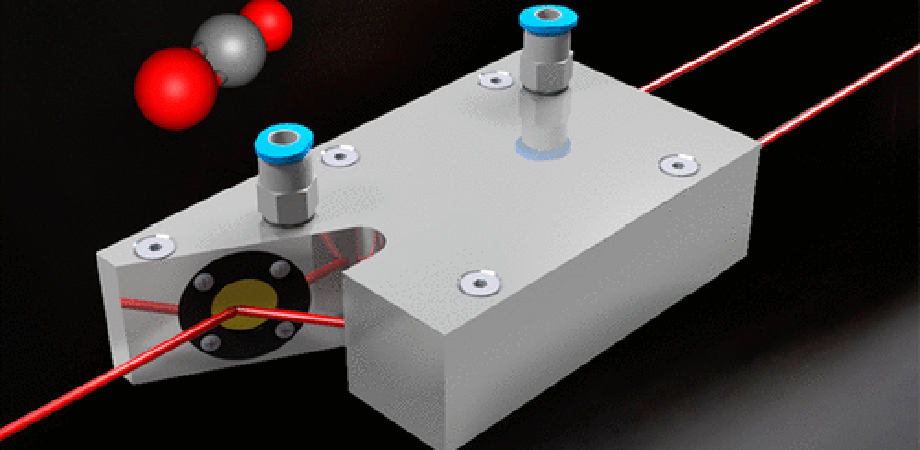Analyzing exhaled breath gases streamlines diagnostics
Potentials for diabetes, lung and gastric cancer, even tropical diseases.

The μBreath device, using a substrate integrated hollow wave guide, measures volatile organic compounds in an exhaled breath matrix. Photo: Ulm University
Hundreds of volatile organic compounds in exhaled breath can be monitored by a new device called μBreath, providing non-invasive clues to aid in disease diagnosis, a researcher's keynote talk demonstrated at the BiOS session at SPIE Photonics West in February.
Three prototypes of the μBreath are at work with mouse models. One of them, at the Ulm University Clinics, is continuously analyzing breath of more than 200 mice, said Boris Mizaikoff, director of the Institute of Analytical and Bioanalytical Chemistry at Ulm University in Baden Württemberg, Germany.
These results have been validated with gas chromatography-mass spectrometry, or GC-MS, analysis.
The technique is also used to get at the molecular pattern of rare tropical diseases in exhaled breath, in a European Union-funded project called TROPSENSE, for tropical disease sensing. Other partners include Morocco, Tunisia, and Colombia.
With infrared sensors, the new device can quickly diagnose diseases in humans, in some cases before the disease breaks out. This capability stems from an EU-funded project called Advanced Photonic Sensor Materials, or APOSEMA.
"We anticipate commercialization within the next two years, either via spinning out a start-up we will establish, or licensing to one of our already involved company partners," said Mizaikoff.
Mizaikoff spoke at the Optical Fibers and Sensors for Medical Diagnostics and Treatment Applications conference. His session was called Sensors, Detectors, and Treatment Tools. He described a smart sensor technology that captures disease-specific molecules in volatile organic compounds, called VOCs.
Analysis of volatile biomarkers has great potential for early diagnosis of diabetes and diseases of the lungs, liver, and kidneys, and even breast cancer. The approach offers efficient monitoring of treatment efficacy and identification of altered metabolic signatures.
Exhaled breath analysis in routine clinical practice remains limited, Mizaikoff said, since sophisticated devices are required for the analysis of trace compounds.
But combining highly selective, mid-infrared cascade lasers with innovative miniaturized gas cells enables portable, yet sensitive, exhaled breath analysis devices, Mizaikoff said.
He showed how breath diagnostics in mouse models have achieved direct continuous monitoring of 13CO2/12CO2 isotopic ratio changes, with just a few hundred microliters of the mouse tidal volume - the normal amount displaced by inhalation and exhalation.
Mizaikoff said his research team pioneered use of innovative substrate-in¬tegrated hollow waveguides (iHWGs) to detect trace gases in very small sample volumes with the required precision.
A system of exhaled breath sensors makes use of interband cascade lasers enabling real-time breath analysis, and oper¬ates as a routine on-line monitoring tool in a mouse intensive care unit with mechanically ventilated and instrumented mice.
Mizaikoff said human-breath technology has long been employed for analysis of biomarkers of human disease stages and progress of therapy targeting gastric cancer. "The 21st century is the century of photonics, and this truly applies in health care," Mizaikoff said, "and it will change way we detect and treat disease."
"Photonics is now being used for disease detection, for monitoring treatment, and it is now even used for treating diseases in patients."
The device marks a flurry of activity going on in waveguide-based photonics, Mizaikoff said. "Waveguides have been an enabling technology, always around, but their use in detection and diagnosis has not been so common yet."
-Ford Burkhart is a science and technology writer based in the US. A version of this article appeared in the Photonics West Show Daily.
| Enjoy this article? Get similar news in your inbox |
|



